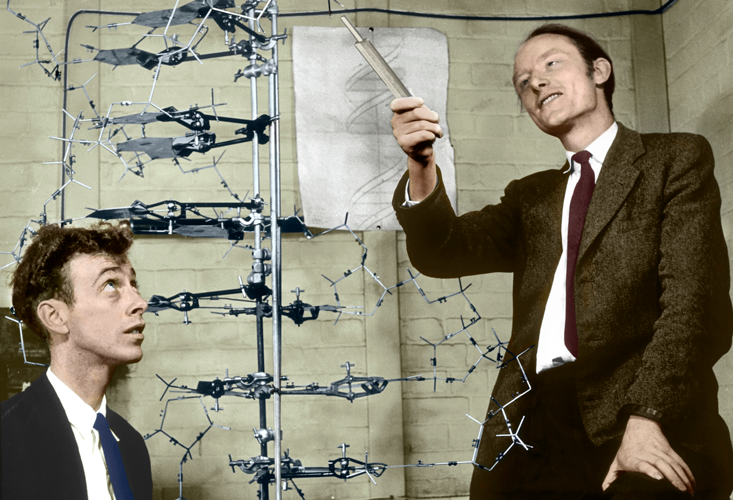James Watson once said his road to the 1962 Nobel Prize began in Naples, Italy. At a conference in 1951, he met Maurice Wilkins, the biophysicist with whom he and Francis Crick shared the Nobel for discovering the double-helix structure of DNA. Meeting Wilkins was when he “first realized that DNA might be soluble,” Watson said. “So my life was changed.”
That’s a nice anecdote for the science textbooks. But there’s “a tawdry first act to this operetta,” writes Howard Markel in his new book, The Secret of Life, about the drama behind the scenes of the famous discovery.
At the time, Watson was an arrogant, gawky 22-year-old, working as a postdoctoral fellow at the University of Copenhagen. His biology lab director, Herman Kalckar, invited Watson and another fellow in the lab, Barbara Wright, to accompany him to the Naples conference. The confident and competitive Watson didn’t think much of Wright’s work. It was “rather inexact,” he sniped. But Watson was pleased to be invited on the trip. “It should be quite exciting,” he wrote his parents.
James Watson is clearly the Iago of the cast. He commits character-assassination of Rosalind Franklin.
Watson was bored with most of the presentations at the conference. But he perked up when Wilkins projected images of DNA, captured with X-ray crystallography. The novel image showed the molecule arose from a crystalline structure. Watson later tried to buddy up to Wilkins at a cocktail party, but the socially awkward Wilkins did his best to avoid the bumptious American. Watson thought he had another opening when he spotted Wilkins chatting with his sister, who had joined Watson in Naples. But when Watson approached them, Wilkins slipped away.
Nonetheless, Watson’s encounter with Wilkins cemented his future. He was determined to discover the precise molecular structure of DNA. He knew he had little chance to join Wilkins at his lab at King’s College at the University of London, mainly because Wilkins didn’t like him. Watson set his sights on joining the other prominent biology lab probing molecular structures. At Cavendish Laboratory Biophysics Unit at Cambridge, Watson met the intellectually unstoppable Crick, and in two years, the duo built the first sound model of DNA’s structure. Their model showed the world how DNA did its thing and shaped the course of biological life.
In The Secret of Life, Markel, a distinguished professor in the history of medicine at the University of Michigan, and author of nonfiction books that roll along like novels, relishes explaining the backstory to Watson’s and Wilkins’ first encounter. Turns out Kalckar was having an affair with Wright and wanted to keep their trysts secret. Watson was invited to Naples “to act as a beard for his boss, to provide cover for his affair with Wright,” Markel told me in a recent interview. In The Secret of Life, Markel writes, “one cannot help but smile at the paradox that the unraveling of the double helix of DNA began with the coupling of Kalckar and Wright.”

That flair of fun wit helps define the tone of The Secret of Life. Markel has mounted on his book’s stage all the players at King’s College and Cavendish Lab who schemed to win favor for their research. Watson is clearly the Iago of the cast. Although Watson doesn’t beguile his boss into killing his wife, he does commit character-assassination of Rosalind Franklin. In particular, Markel told me, Watson’s 1968 book, The Double Helix, “really did a number on her.” Watson’s portrayal of Franklin as a raging termagant who one day “in her hot anger” was going to strike Watson for interrupting her constituted one scene that lived in infamy for years.
The London-born Franklin, a chemist and mathematician, drove herself to perfect X-ray crystallography. The process to determine the atoms that constitute a molecule is painstakingly slow. Crystallographers take hundreds of photographic images of a molecule and apply complex mathematical formulas to determine its final shape and size, informing them which atoms are involved. After the preternaturally meticulous and patient Franklin made a name for herself in crystallography, she was hired to deconstruct DNA at King’s College. Wilkins felt DNA was his dominion and Franklin was being hired as his assistant, not an independent scientist with her own mind and methods.
Wilkins and Franklin never got along. Markel amplifies a chorus of their colleagues on why. Watson blamed Franklin for refusing to accept her role as Wilkins’ assistant. In The Double Helix, he wrote, condescension dripping from his pen, the real problem was “Rosy.” Others say Wilkins was jealous of Franklin, intimidated by her, resentful of her for correcting his science in public, or, as Crick wrote, Wilkins “was in love with Franklin,” adding, “And Rosalind really hated him … either because he was stupid, which was a thing which always annoyed her, or else something else happened between them.” In any event, Crick said, it was a “big love-hate thing between them.”
There exists no ethical standard whereby Franklin’s permission did not need to be expressly asked.
Markel offers a multifaceted portrait of Franklin. He quotes a letter from Mary Fraser, a biophysicist at King’s College, who wrote Franklin didn’t want to mix with anybody in the lab. Wilkins was “tall, quiet, gentle, a brilliant experimentalist who normally would never quarrel although he could be stubborn,” Fraser wrote. Meanwhile, Franklin’s “manner was rather brusque and everyone automatically switched-off, clammed-up and obviously never got to know her. She couldn’t be bothered with social chit-chat—it was a bore and a waste of time.” Franklin “was too obsessive and took everything too personally—if she had suggested to Wilkins that help was needed with the problem it would have been alright but she didn’t want any help.”
Markel told me a big part of his inspiration for writing The Secret of Life were his two daughters, Samantha, 16, and Bess, 21, who had long been after him to write about Franklin. “They aren’t science-y kids,” Markel said, but were aware of Franklin. As they understood her story, Franklin was never taken seriously by her male lab mates, was constantly the subject of their sexist gossip, and had her work stolen by them. “I kept saying to them, ‘Well, wait kids. You’ve got to look at the data. You’ve got to look at the facts. You can’t assume. That’s not the way we do things,’” Markel said. “And then when I got deep into the research, it was startling. I was like, ‘Whoa, this is far worse than I thought in terms of the evidence.’”

Markel is not the first to report one of the worst episodes in the double helix drama—that Wilkins, without Franklin’s knowledge, went into a file room and retrieved a photographic print, created by experiments designed by Franklin, and showed it to Watson. The print, “Photograph No. 51,” revealed that DNA had a three-dimensional form in the shape of a double helix. “The instant I saw the picture my mouth fell open and my pulse began to race,” Watson wrote in The Double Helix.
The famous incident was reported by Horace Judson in his 1979 book, The Eighth Day of Creation, and presented with rich context by the late biographer, Brenda Maddox, in her 2002 book, Rosalind Franklin: The Dark Lady of DNA. It has been discussed in interviews and books by most of the star and supporting characters, including Wilkins and Watson, and Raymond Gosling, a Ph.D. student who worked with Franklin. It provided a key dramatic turn in the 2015 play, Photograph 51, which starred Nicole Kidman as Franklin in its London premiere. The incident has been interpreted so often it provides a lesson in history, how the truth of an event can be fractured into many viewpoints.
Markel acknowledges the Rashomon effect of the incident, and the many sources for it (his footnotes throughout the book are thorough), but he himself doesn’t see any moral ambiguity in it. “Quite simply, it was not all right,” he writes. “There exists no ethical standard whereby Franklin’s permission did not need to be expressly asked, and because permission was not requested, Wilkins’s showing Watson Photograph No. 51 remains one of the most egregious ripoffs in the history of science.”
Watson and Crick had a vested interest, while they were alive, of burnishing the story of the double helix.
The purloined photograph was the first offense against Franklin. Max Perutz, director of a Cambridge biophysics research unit, which brought together labs working on similar projects, showed an analytical report on DNA by Franklin and Gosling to Watson and Crick, again without Franklin’s permission. The paper set off a chain reaction in Crick’s brain, Markel writes, and allowed him to comprehend the structure of DNA, with two backbone chains that spiraled around the molecule’s inner core, the paired nucleotides. In The Double Helix, Watson wrote the rationale for the double helix arose from the notion that biological things came in pairs. “That’s just nonsense,” Crick later said in an interview. Crick admitted he and Watson “needed a clue to get to that point, and the clue was Rosalind Franklin’s data.”
Crick, in Markel’s telling, is the more sympathetic of the DNA duo. Franklin, in her 30s, developed ovarian cancer, “which may have been the result of the massive radiation exposure she experienced during her laboratory work,” writes Markel, who is a physician. Markel remarks cancer treatment in the 1950s was “akin to medieval medicine,” and details the effects of the procedures on Franklin with unflinching clarity, exposing the depths of her suffering. During some of her direst times, Franklin convalesced with Crick and his wife Odile at their house in Cambridge. Franklin’s sister, Jenifer Glynn, whom Markel interviewed, said Franklin held no resentment against Crick and Watson. She died in 1958 at age 37. Crick later told Anne Sayre, a friend and biographer of Franklin, that Franklin would have solved the structure of DNA; “with Rosalind it was only a matter of time.”
Given Crick’s respect for Franklin, his and Watson’s final crime against her is exasperating. With “sinister manipulations,” Markel writes, Crick and Watson maneuvered to omit a formal citation of Franklin’s data in their 1953 Nature paper, spelling out their construction of the double-helix model. When they and Wilkins won the Nobel Prize in Chemistry in 1962, neither Crick nor Watson mentioned Franklin in their Nobel Prize lectures; Wilkins mentioned only that she “made valuable contributions to the X-ray analysis.”

Markel reviewed the nominations for the 1962 Nobel in Chemistry at the Royal Swedish Academy of Sciences by “some of the most accomplished and well-informed scientists of the day.” Not one of them mentioned Franklin. In fact, she was not eligible for the prize, which is not awarded posthumously. Markel, however, did unearth a 14-page report for the 1960 Nobel in Chemistry by Arne Westgren, a professor of chemistry who was well versed in crystallographic studies of DNA and protein. Westgren wrote that Crick and Watson produced an ingenious hypothesis, but those who deserve the most credit for deciphering the DNA molecule are Wilkins, Franklin, and Gosling. A reward for Crick and Watson that bypassed those three “would not be worthy of consideration,” Westgren wrote, adding that if Franklin survived “she could well have had claims to receive her part of the prize.” Clearly, the Nobel Prize committee wasn’t moved. And neither, to this day, is Watson.
In 2018, Markel interviewed Watson. The glow of Watson’s public reputation had been extinguished by the racism in his repeated comments that blacks possessed an inferior intelligence to whites because of genetics. In The Secret of Life, Markel shows Watson’s racism was always part of his character. When Watson was in Naples in 1951, he wrote to his parents, “The entire city can be described as a slum and the people are wretchedly poor, living in slums which make the Negro section of Chicago look almost pleasant in comparison.”
Markel asked the 90-year-old Watson if, in a perfect world, and Franklin were alive in 1962, she didn’t deserve to have shared the Nobel Prize with him? “He slowly rose from his chair and, with one finger pointing directly at me pronounced from on high, ‘You don’t usually win the Nobel Prize for data you can’t interpret,’” Markel writes. Markel pushed Watson on the question, saying that Wilkins in 1953 couldn’t interpret the data either. Watson, chuckling, replied, “We wanted Maurice to get the Nobel, too, because we all liked him ….”
Markel told me he was familiar with egos and jealousies running rampant in the production of science. The process was practically always steeped in politics. “There is always competition, in-fighting, and bad behavior, and I could talk your ear off about my own career, where I’ve seen it happen,” Markel said. He offered one example. In the 2000s, he was working on analyzing infectious diseases, notably the H5N1 avian flu virus, with CDC officials. In a 2007 paper, he coined a term for how infections could be curtailed by implementing actions for people to keep a safe distance from one another, the now ubiquitous “flatten the curve.” As Markel was amassing the data, and helping design social measures, he told me, “Everybody was saying, ‘Hurry up, hurry up, we’ve got to get the data, we’ve got to do this, do that.’ I understand the dynamic at play.”
Still, I wondered, how did Markel explain how Watson and the more likable Crick committed the egregious sin of burying Franklin’s role in cracking life’s biological code? “They had a vested interest of burnishing the story of the double helix,” Markel said. “They wanted to control history by telling their story.”
In the beginning of The Secret of Life, Markel writes, “Buried under layers of interpretation, explanations, and obfuscation, the discovery of DNA’s molecular structure is one of the most misunderstood whodunnits in the history of science.” At the end of the book, I was pleased to feel that I understood who had done it.
Kevin Berger is the editor of Nautilus.
Lead image: A. Barrington Brown, © Gonville & Caius College / Colored by Science Photo Library























